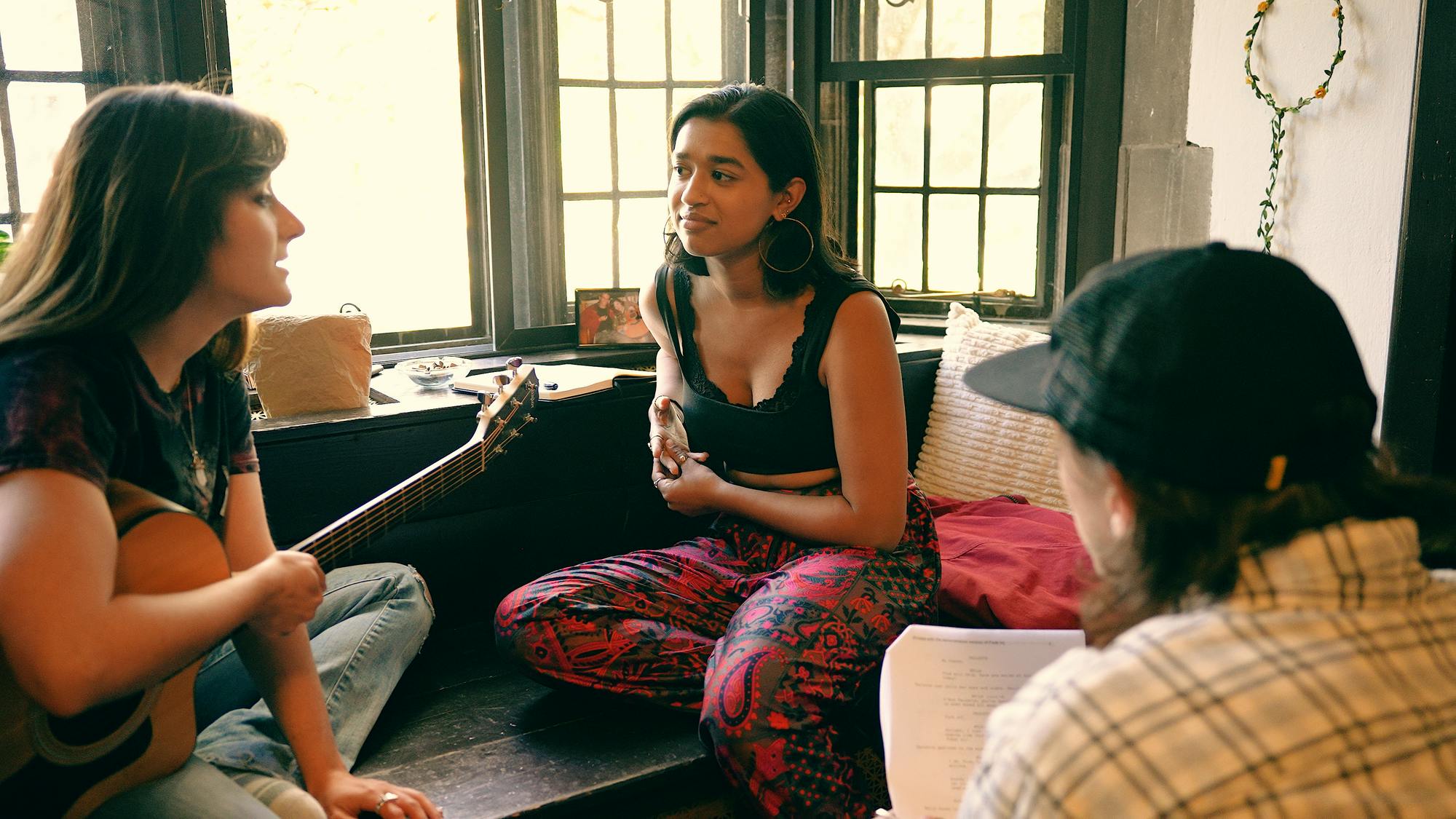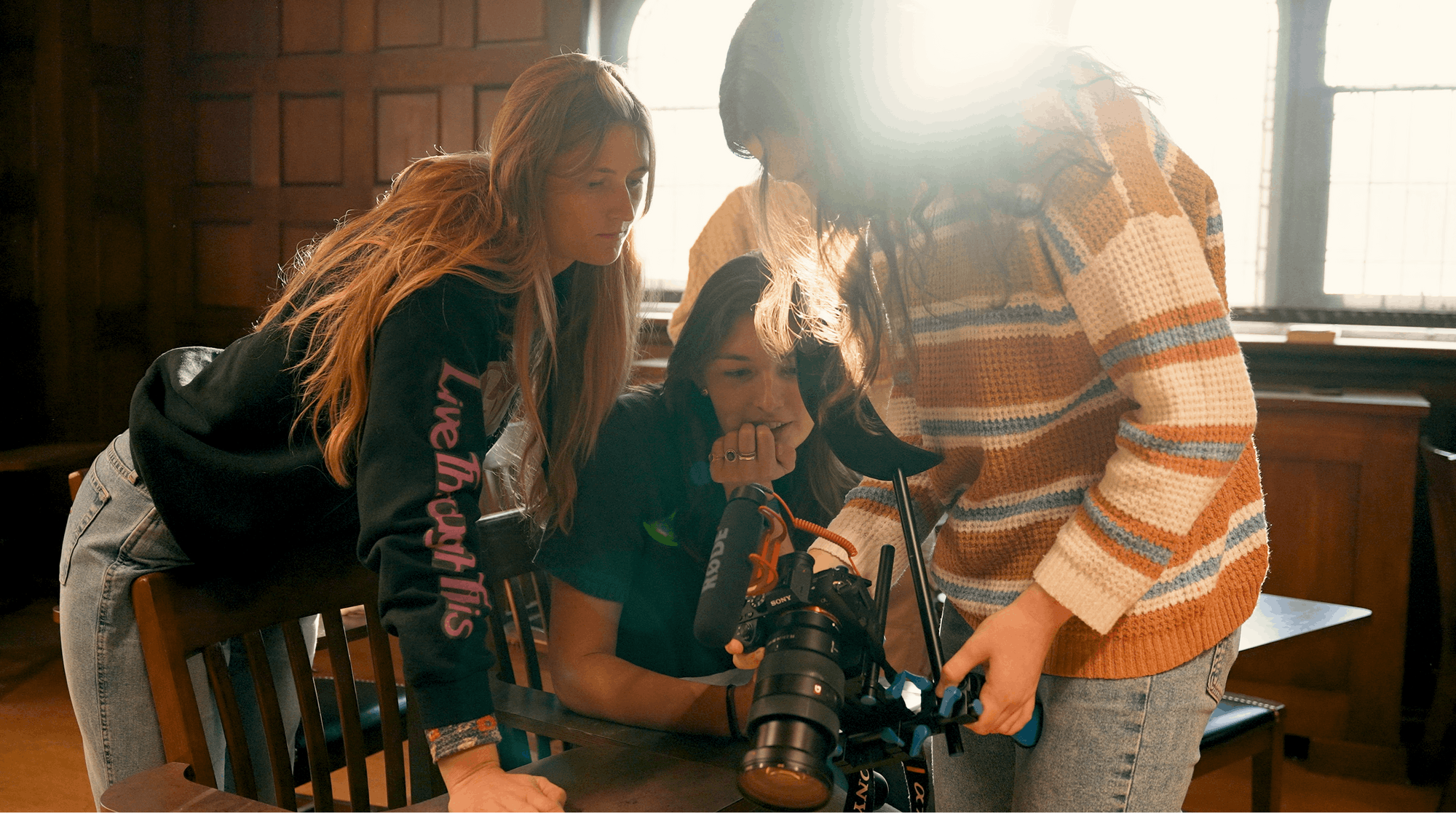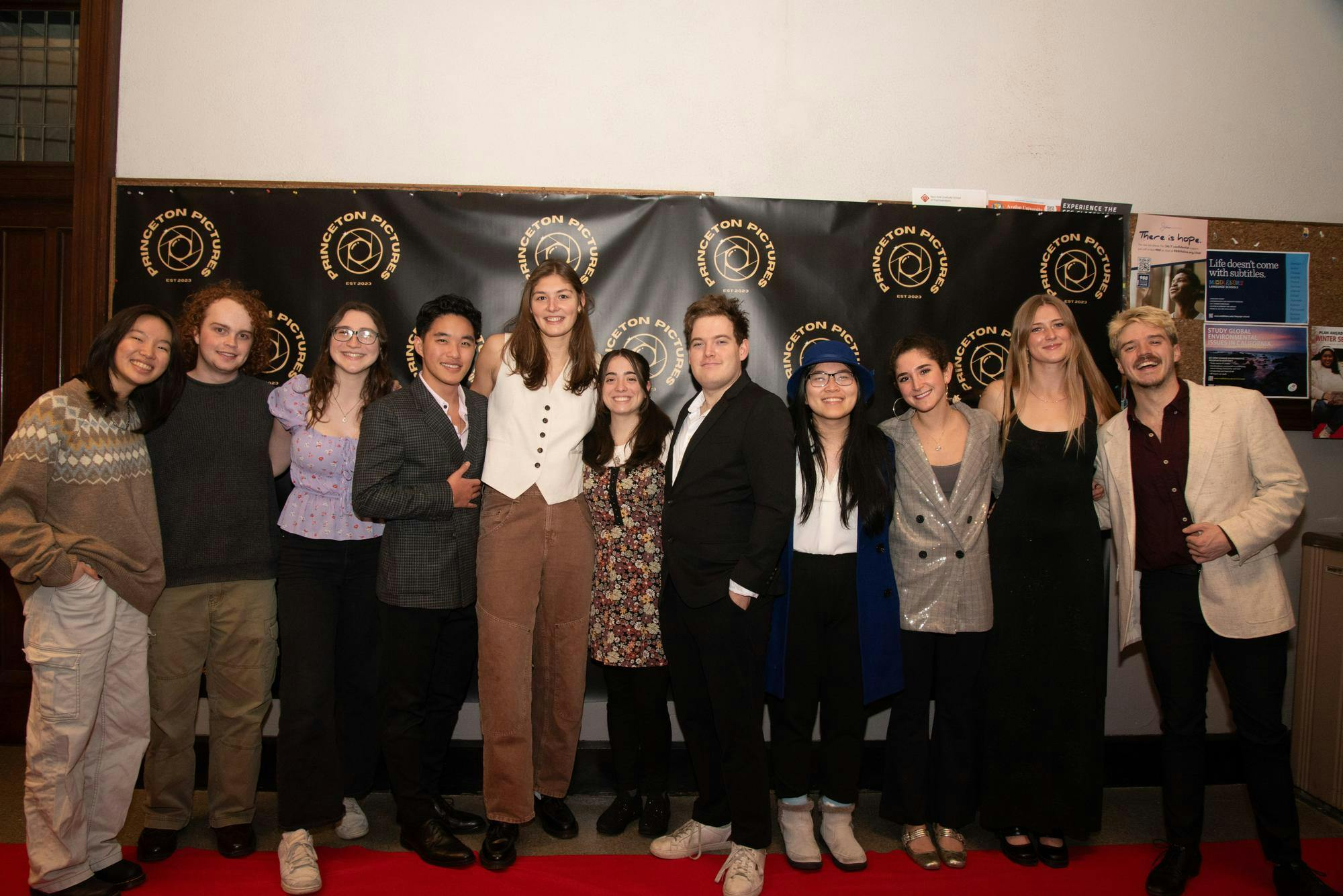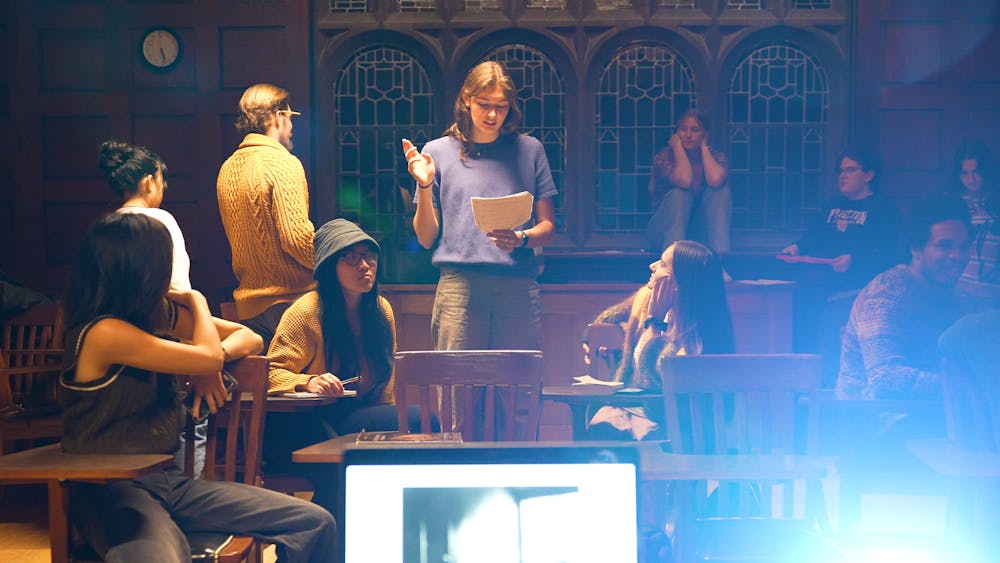“Film is the best artistic medium. It combines every aspect of art. It’s visual. It’s audible. But at its core, it’s human,” said Connor Odom ’26. Odom first got into film in fifth grade, when he acted in a small role in a short film. He transferred to Princeton in fall of 2022, after working for seven years full-time in the videography and film industry.
“I'll never forget it,” he added. “It changed my life, being on set and seeing the whole operation around me — all the lighting, the directing, the energy.”
But upon arriving at Princeton, Odom found that there was “no film community on campus.”
“There were a lot of people that were across campus that had [an] interest in doing film,” Odom said, “but there wasn’t an outlet for that.”
Similarly, Hailey Mead ’24 had served as treasurer of Princeton Film Productions, but she said it dropped off in 2021 due to disruptions caused by the COVID-19 pandemic. In 2022, however, when students flocked to the “Oppenheimer” filming in East Pyne courtyard, she realized lots of students were still interested in film.
Looking to rebuild the campus film community, Mead, Odom, and Kate Stewart ’25 founded Princeton Pictures (PPic) in the fall of 2023. Mead is the PPic president, and Odom is the vice president. Stewart is the co-director of PPic’s Princeton Film Festival in the spring. In its first year, the club has grown to approximately 150 members.
A production-based film club, PPic’s crew works hands-on with all the fundamentals of film production, from screenwriting, casting, and filming on set, to sound directing. In this way, PPic distinguishes itself from networking-focused film clubs like Princeton in Hollywood or clubs focused on film screenings and reviews like the recently restarted Princeton Film Society. Before PPic, students gained hands-on experience through the Princeton Film Productions group, which last held a 48-hour film festival in December 2022.
“I would love to see in my lifetime more Princetonians be directors and writers,” Odom said. “And I think that starts with clubs like this existing and people having the chance to be on set.”

“We started at ground zero,” said Mead, who worked to start PPic as her entrepreneurship certificate project. The team began with formulating the club’s infrastructure and processes and focused outreach at activities fairs, social media, and word of mouth. In the fall, 25 students — serving as screenwriters, directors, producers, sound supervisors, and editors — produced two films: “Passenger” and “Paint Loss.”

Sam Spector ’24 and Sabina Jafri ’24 are guided through a scene by Director Eric Fenno ’25 on the set of "Passenger."
Photo by Michelle Tang ’26.
Passenger
Eric Fenno ’25 wrote and directed the nine-minute film “Passenger,” a romance that follows a girl’s songwriting process to cope with her boyfriend’s car crash, with the narrative flashing between past and present.

“Combining music and visuals is something that I think is really interesting,” he said. “Music sets the tone and even provides characterization. It creates a whole atmosphere for the movie.”
Though Fenno had pursued small independent projects with friends or for classes, “Passenger” was the first time he had an entire crew behind him.
“It’s important to know that as much time as I spent working on this film, I didn’t make it,” he said. “There are so many different elements that I technically oversaw, but a lot of the time [I] left it to the people who were specialized in those areas. An army of us made it.”
Fenno came to understand all the “little things” to pay attention to during filmmaking: weather changes during outdoor scenes, motion alignment between takes of running shots, and the inference from unpredictable background noises such as a baby crying.
“It’s a lot of fun, but filmmaking is no joke,” Fenno said. But when everything comes together, he added, “You really get a sense of that movie magic.”
The “Passenger” director added that film as an art form makes him see beauty where he wouldn’t have found it before.
“There are so many stories or images you come across every day that can easily be dismissed as ordinary life or even negative,” Fenno said. “Film has allowed me to see a lot more of those things as beautiful stories or images. Especially around [campus], there’s so much to be seen and to be heard — it makes me really appreciate a lot of those things more than I would have.”

Hailey Mead ’24, Paige Morton ’25, and Marisa Hirschfield ’27 checked a shot on the set of “Paint Loss.”
Photo by Michelle Tang ’26.
Paint Loss
Paige Morton ’25, an art and archeology major with a concentration in film and a varsity basketball player, started making YouTube videos when she was 14 years old and fell in love with video editing.
“When I got to college, I took a narrative filmmaking class,” Morton said, “and that really just changed my life. I really felt like I found what I love to do in that class, and then I became a film major.”
Morton wrote and directed the original script of “Paint Loss,” a nine-minute comedy and horror film. The plot follows two girls in an art class about painting the people they grieve — Marilyn paints her missing boyfriend, who the second girl, Bonny, was holding hostage. Jealous of Marilyn’s boyfriend for being the best art student, Bonny held him hostage to produce a painting that would earn the approval of her art teacher.
“I had been thinking about horror movies, and I kind of wanted to put a little fun spin on them,” Morton said. “I also wanted to utilize the dark academia vibe [on campus] and the energy of the troubled psycho artist.”
When it came time for staging and production, Morton noted the “raw energy” on set. “Everyone’s kind of willing to do whatever it takes,” she said.
Morton said she was impressed by the openness of the PPic community, explaining, “There are people from all different experience levels, which is awesome. Receiving only a budget of $500 from ODUS, she noted, “We don’t have these crazy Hollywood budgets, so you have to be super creative with your limitations.”
As a first-time producer on “Paint Loss,” Mead gained insight into the collaborative process.
“I’ve learned to totally trust the people that I work with and trust the decisions that the directors make,” Mead said. “When I was on set for ‘Paint Loss,’ everybody was smiling and just having a really good time on set.”
The Premiere
The club’s most notable event was a red-carpet premiere of the two student-produced films on Dec. 12 in McCosh 10. Fancy attire was encouraged at the event, which included photographers and a Q&A with Morton and Fenno after the screening.
With a total of 220 attendees at the premiere, Morton remembered feeling very nervous, but noted that she still had a good time with her basketball team, friends, and film crew.
“It’s always scary to show your work in front of people,” she explained. “I’ve never really felt comfortable doing that, and I don’t think I will ever get chill about that. But overall, it was so fun.”

The cast and crew of “Paint Loss” smiles at the Princeton Pictures Fall 2023 Premiere.
Photo by Brad Rindos ’23.
One of the attendees, Madison Linton ’24, said it was her first film premiere and that she was impressed by the contrast between the two films. “The stark difference between the genres pulled a large group of people together,” Linton said.
“The amount of community that [PPic] have been able to build in just the past year has been incredible to be able to watch and experience,” she added. “I’m really looking forward to what they produce next.”
Beyond the premiere, Odom and Mead share the larger goal of creating a supportive campus filmmaking community outside of an academic context. Odom explained that because film requires more technical equipment than other art forms, it requires more funding and is less accessible.
There is no official film major or minor on campus. Students can either major in Art and Archeology or minor in Visual Arts, with a concentration in film. Only 4–8 students are accepted as visual arts film minors every year.
“That’s kind of the problem,” he said. “You have people like me, who have worked in the industry, who are applying against someone who is newer to the art form but has an actual interest in the art form, but won’t get the chance to do it because the department is so small.”
The VIS department did not respond to a request for comment by the time of publication. The Daily Princetonian has previously reported on difficulties with high demand for VIS resources and funding.
As PPic looks ahead, Mead also emphasized staying faithful to the PPic’s DEI values while deciding on new scripts for production.
“[Our goal is] to have more diverse stories be told,” Mead said. “We are hoping to expand into new genres this semester and make sure we have a strong infrastructure to support that growth.”
This semester, PPic will be directing “Double Dash” and “The Reverie,” which are thriller and horror/mystery films, respectively. The club will host a Princeton Film Festival (PFF) instead of a premiere, which will take place over a few days in April to include more screening events and workshops.
Through PPic’s larger-scale initiatives, Odom said that his ultimate goal for PPic to be comparable to larger arts communities on campus, like theater and dance.
“A lot of things in museums are hard to identify with [on] a human level,” Odom said, “but movies and TV have this way of connecting to us on a human level that other art forms can’t.”
Chloe Lau is a staff Features writer for the ‘Prince.’
Please direct any corrections requests to corrections[at]dailyprincetonian.com.








